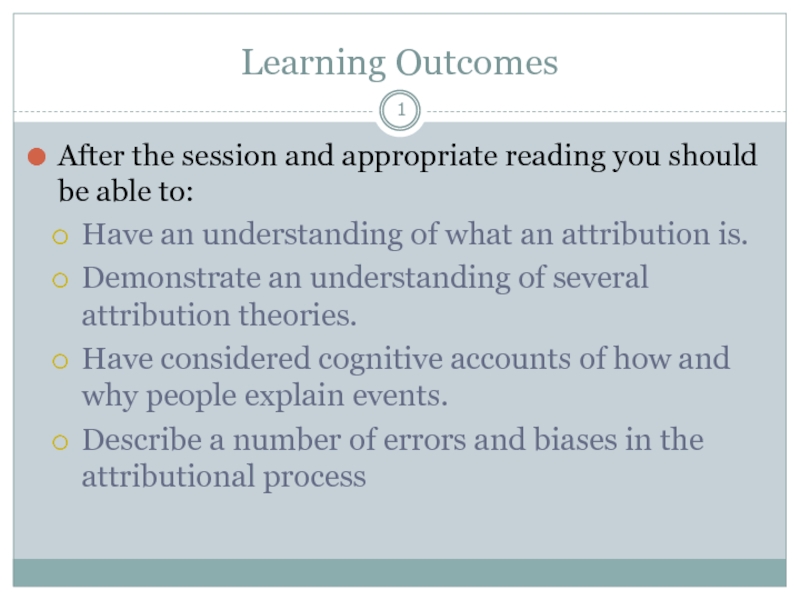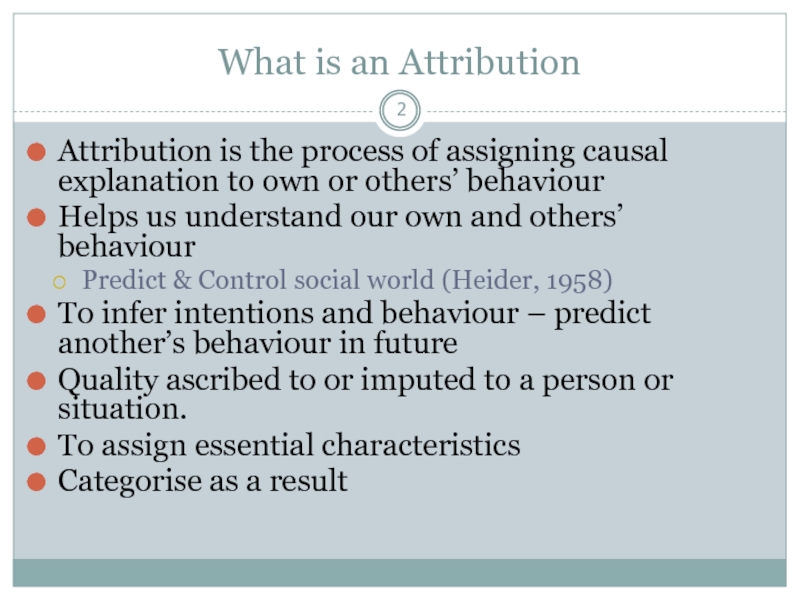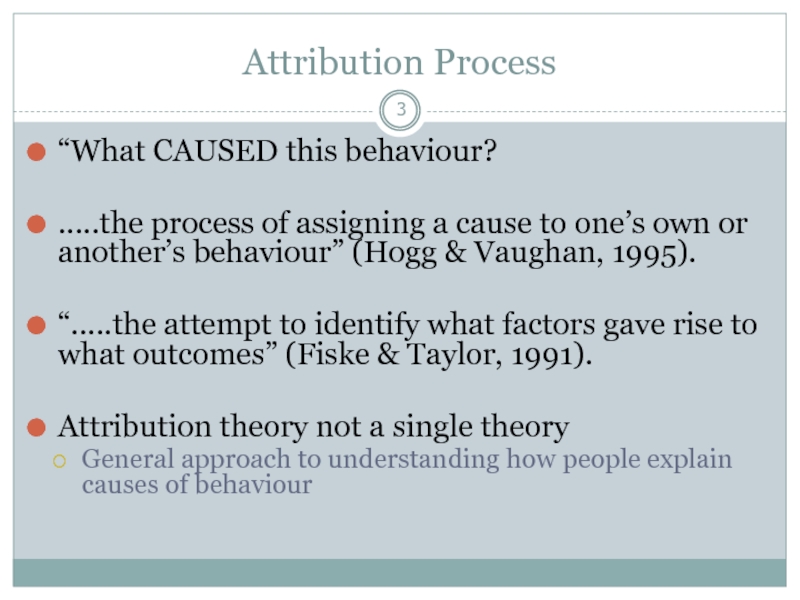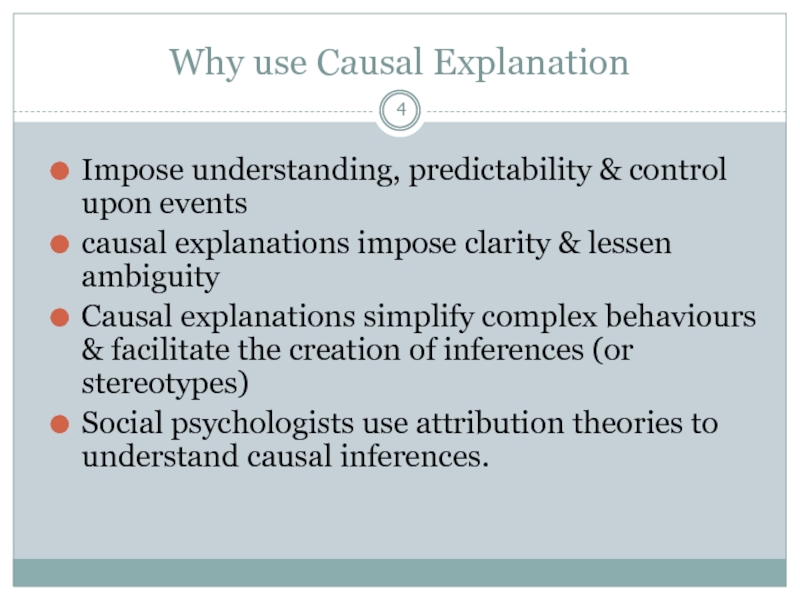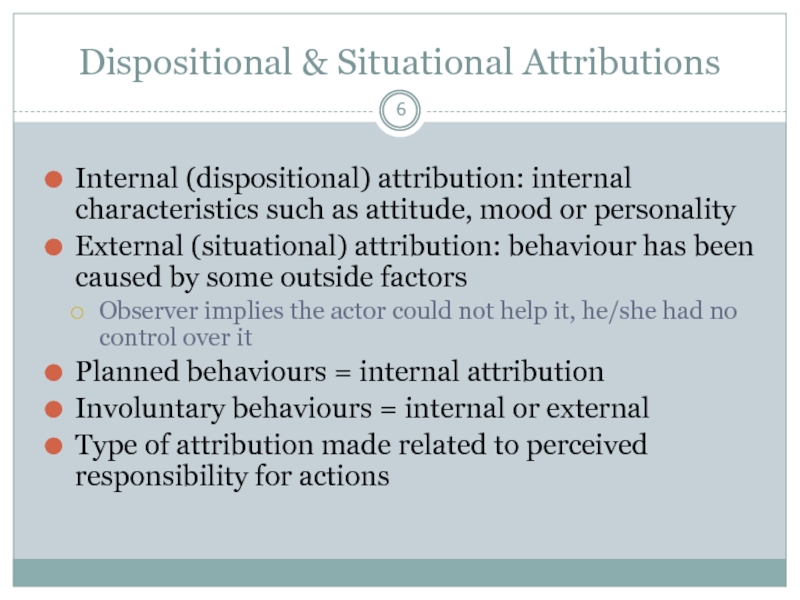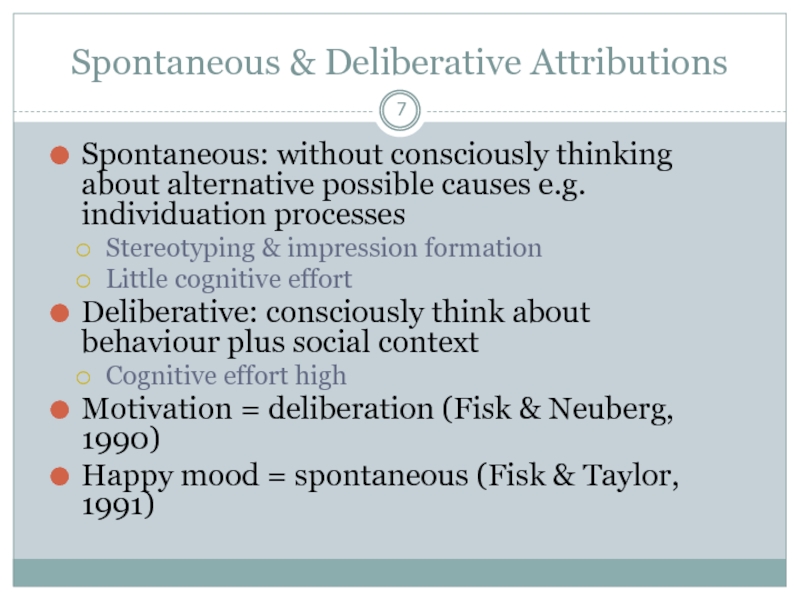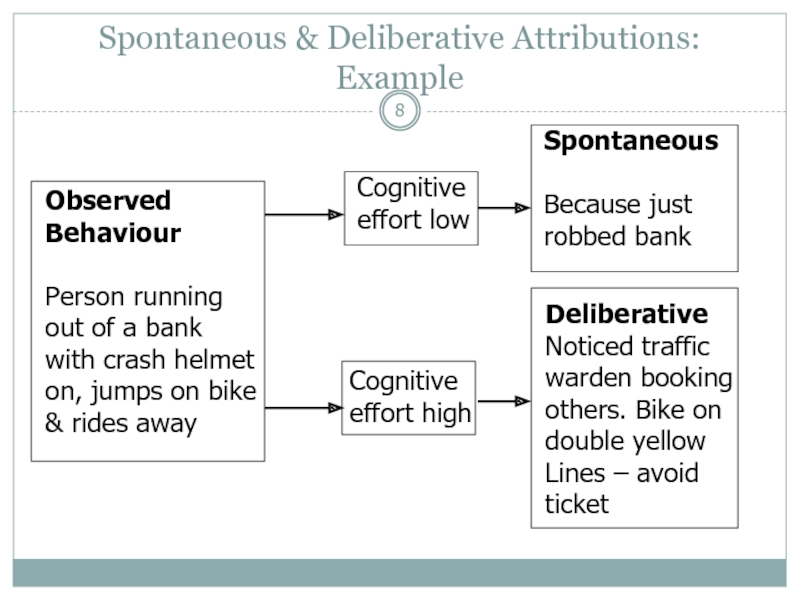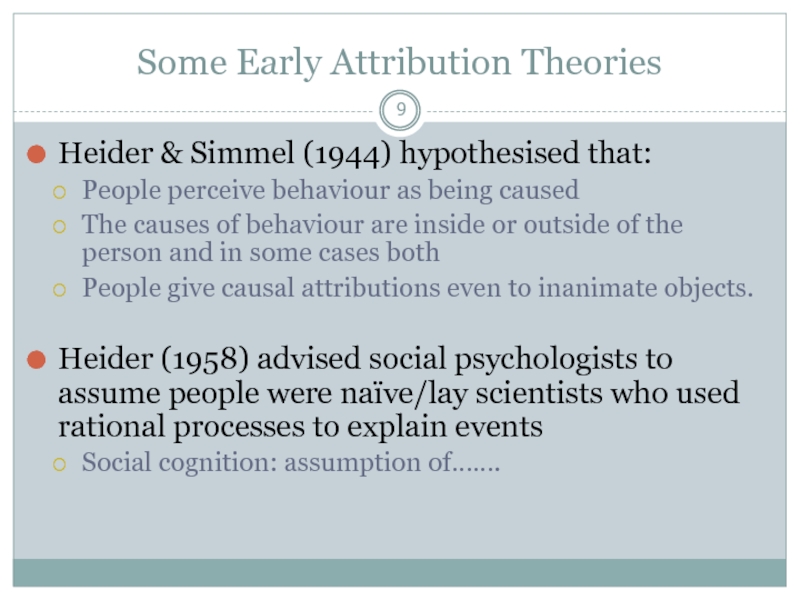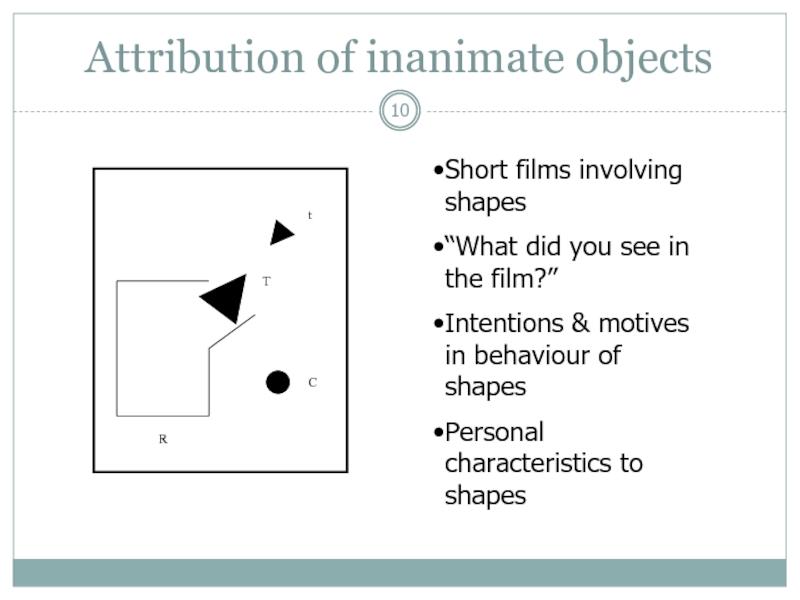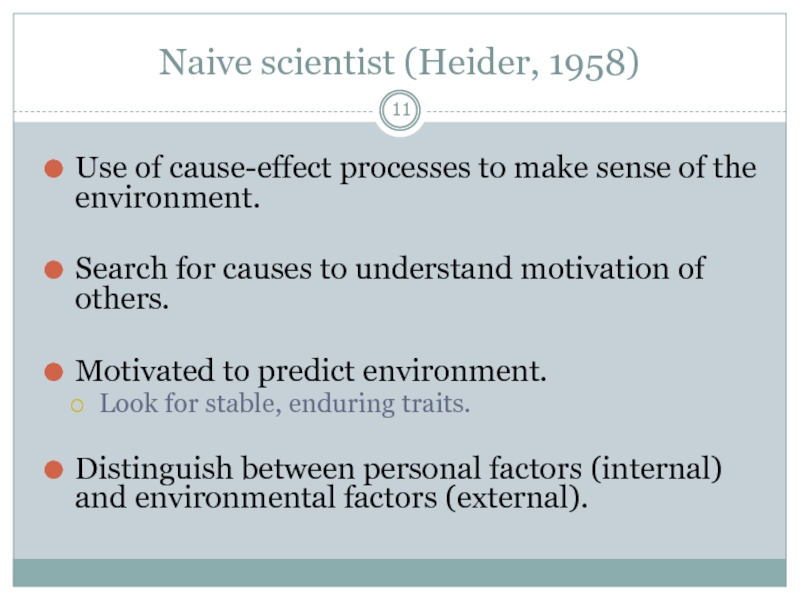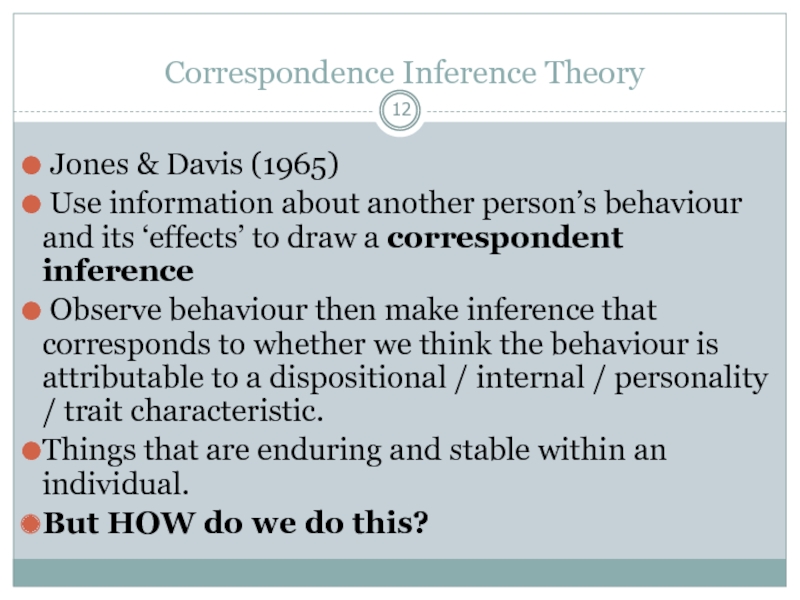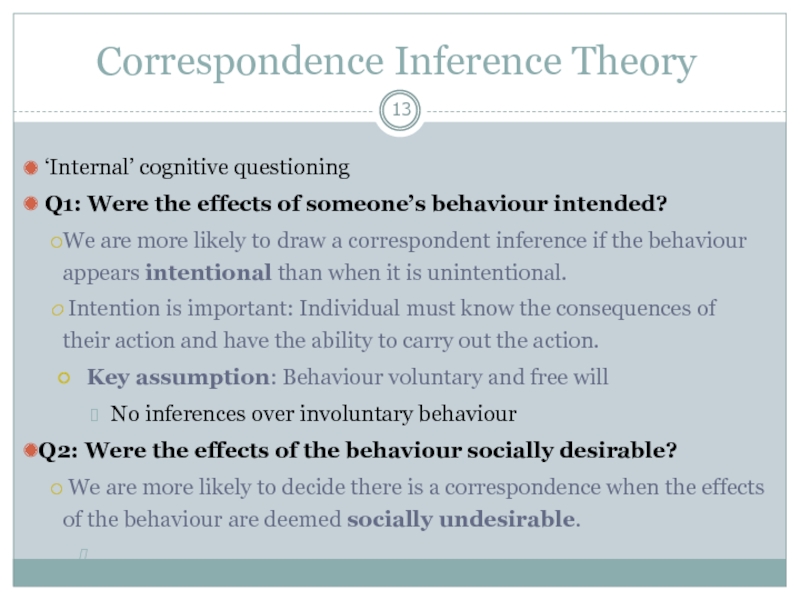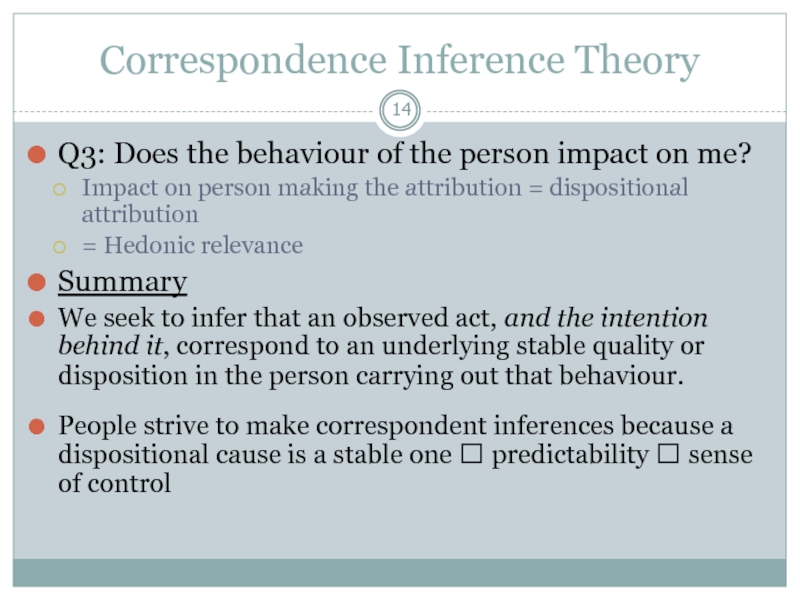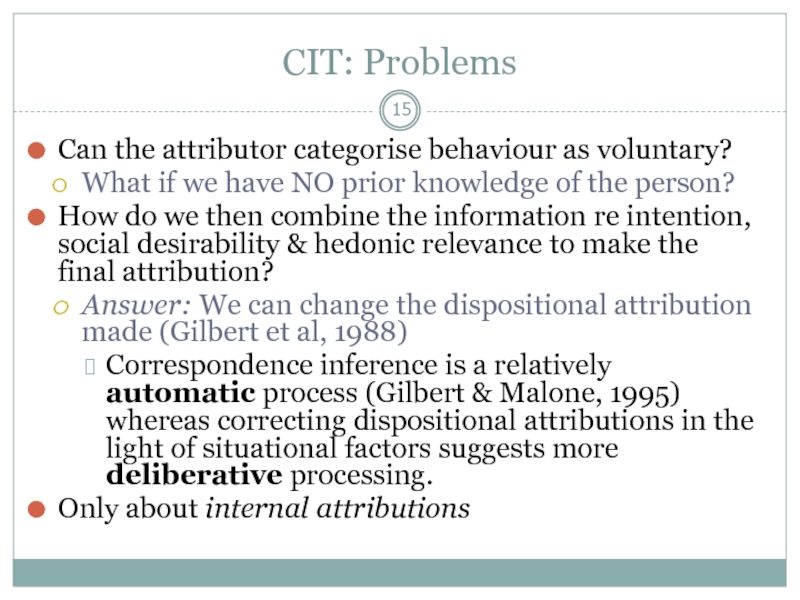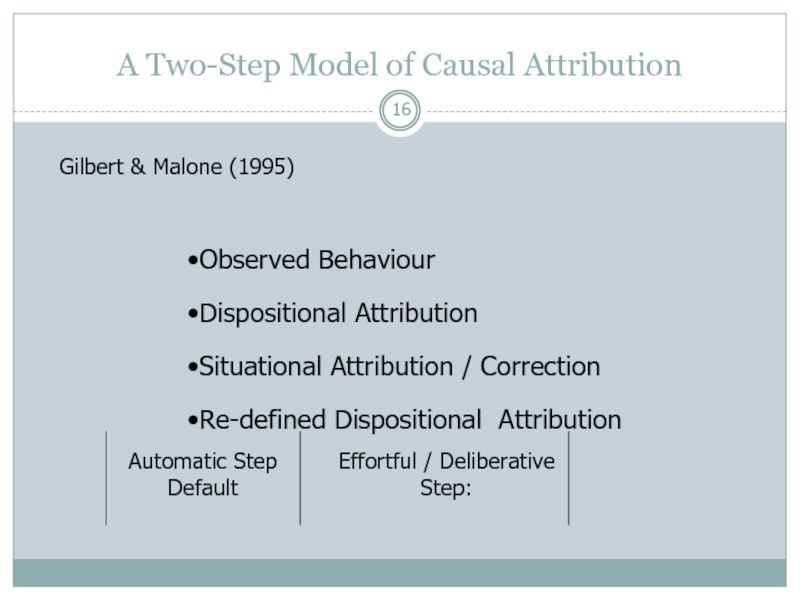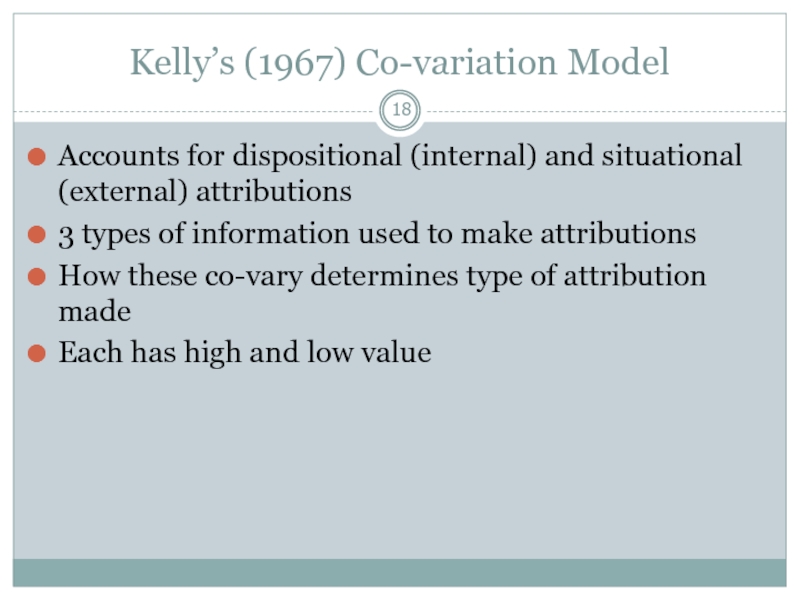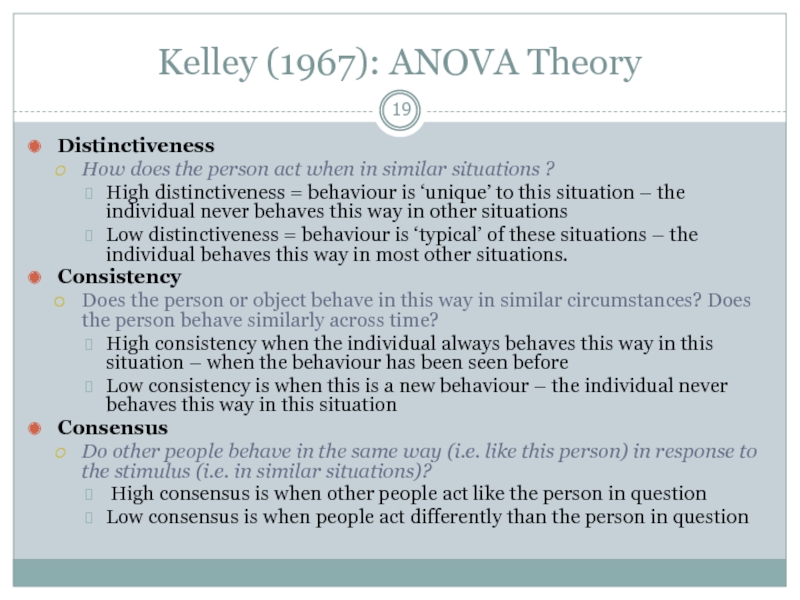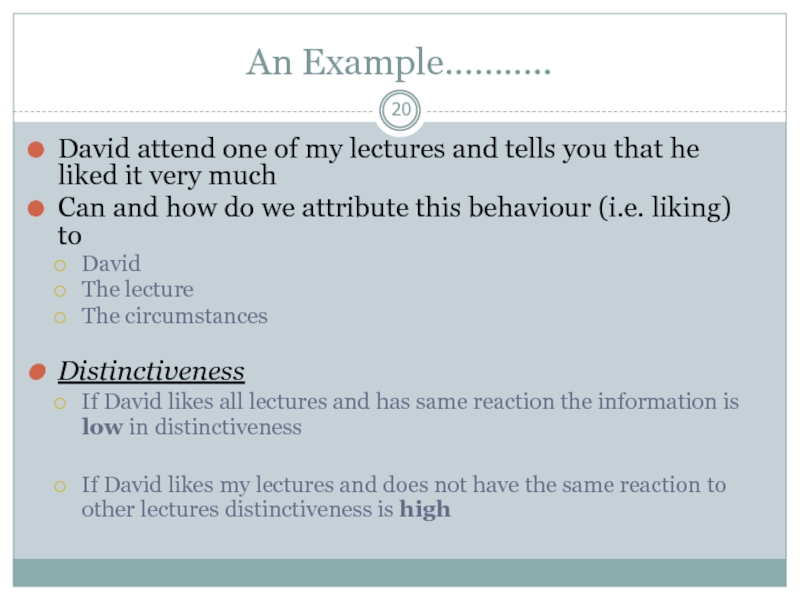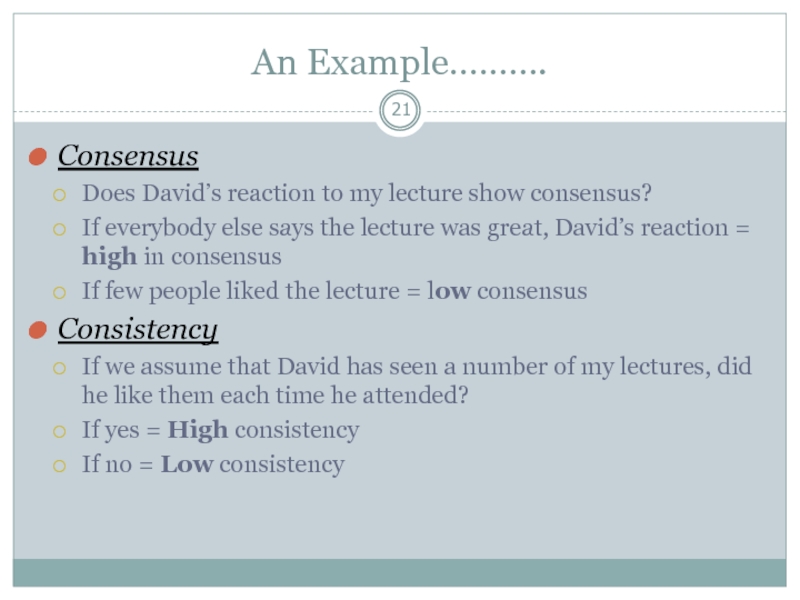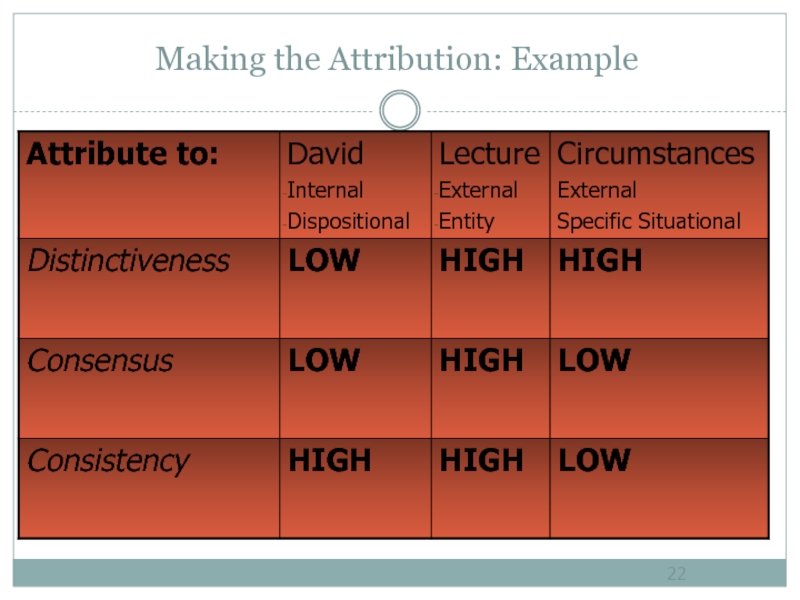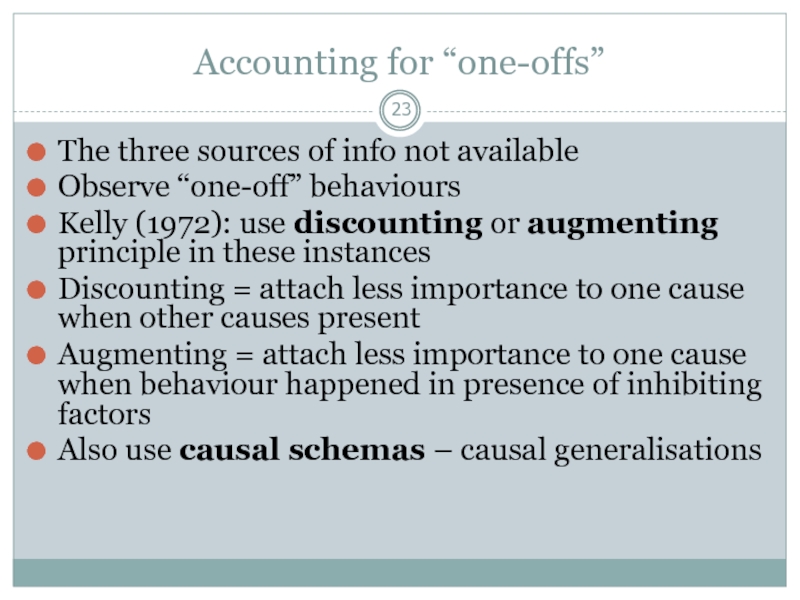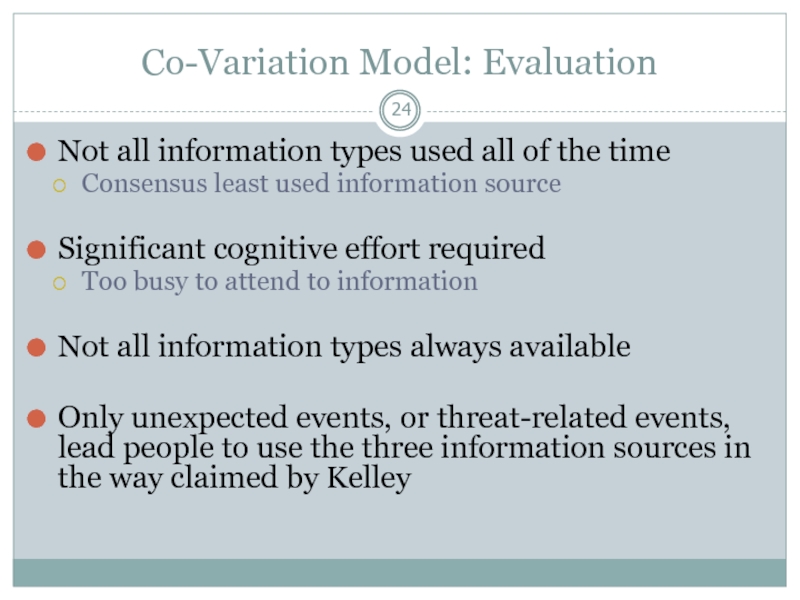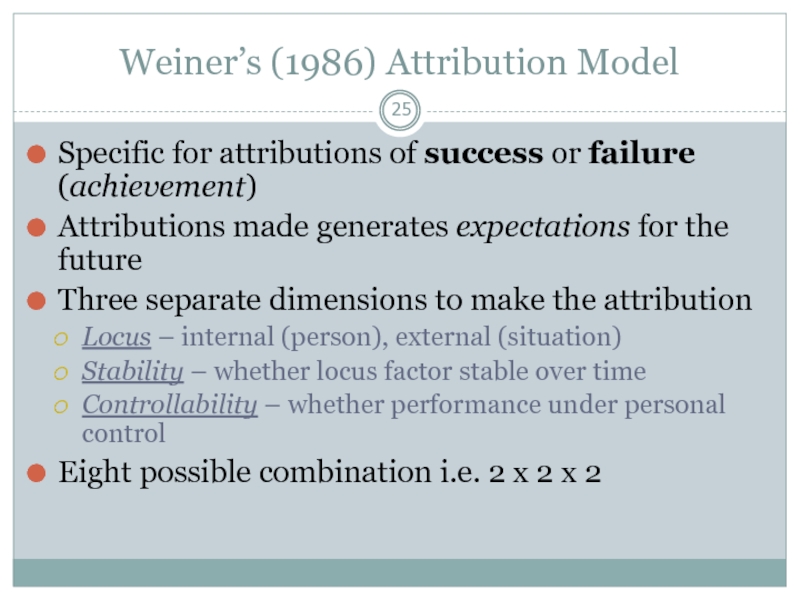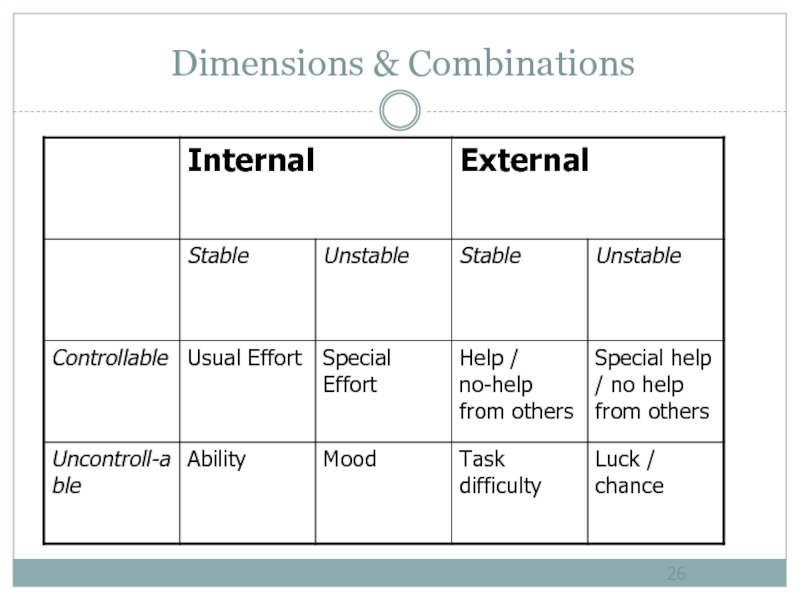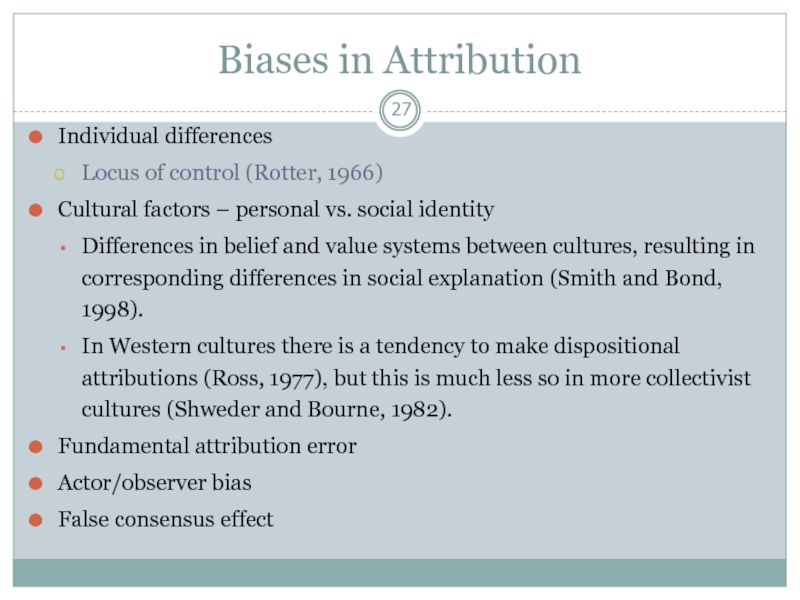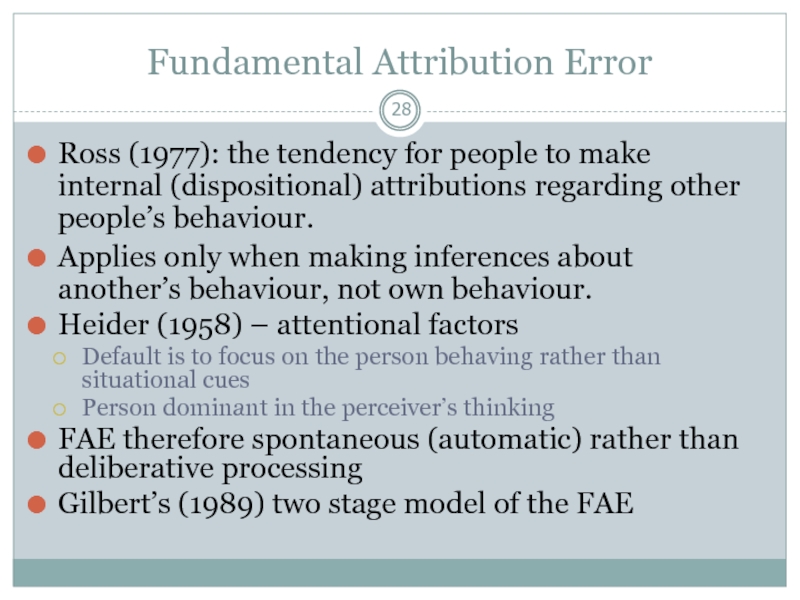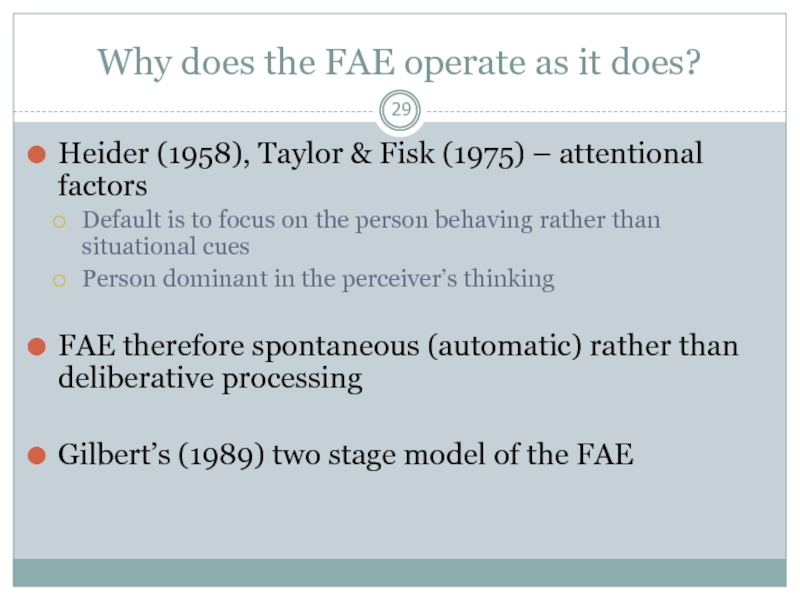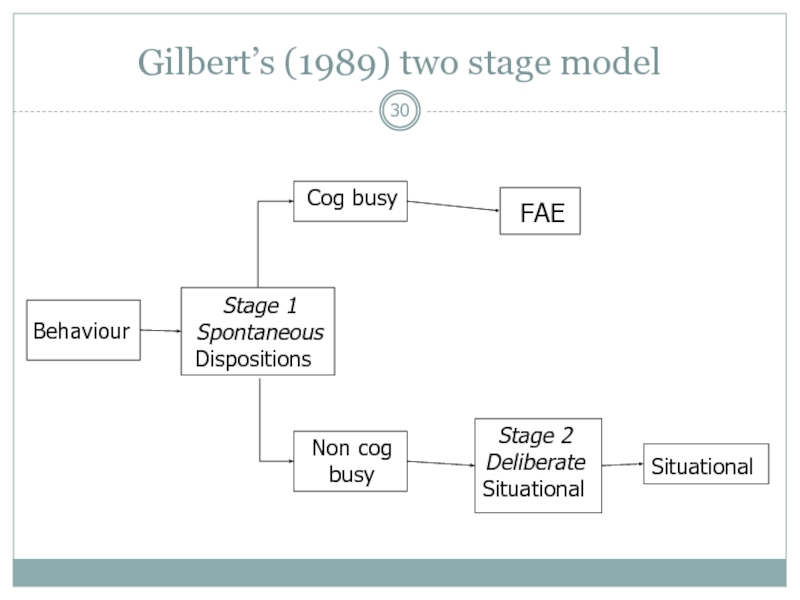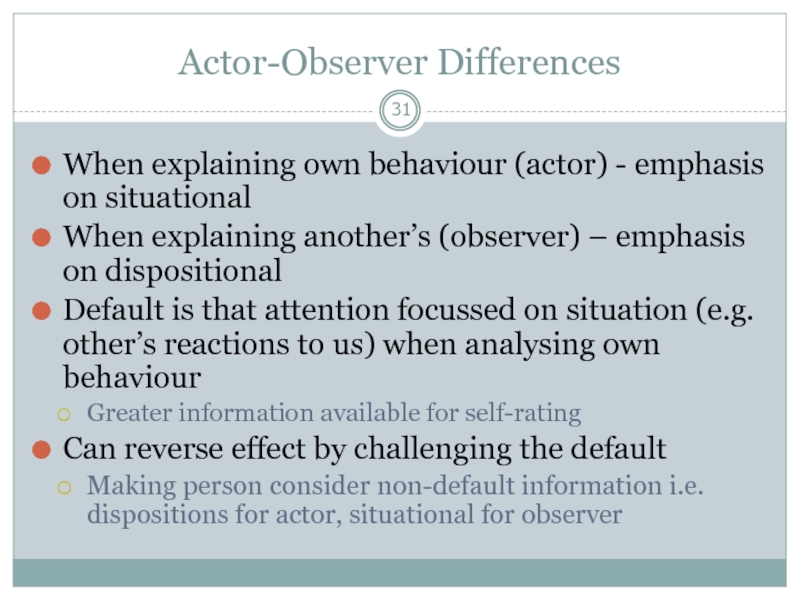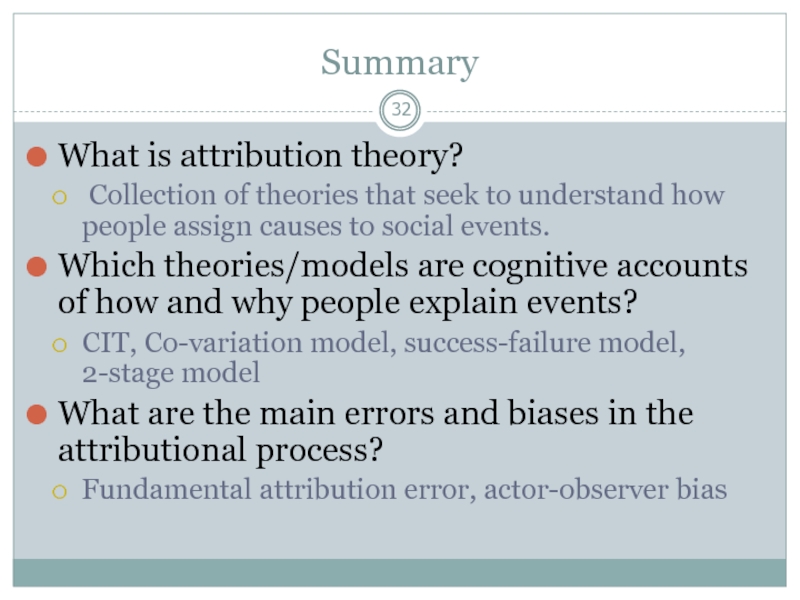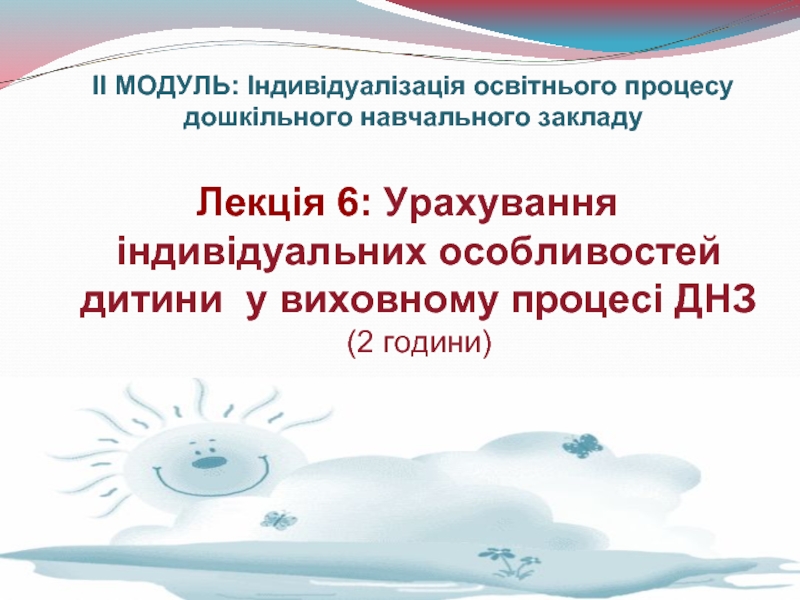to:
Have an understanding of what an attribution is.
Demonstrate an understanding of several attribution theories.
Have considered cognitive accounts of how and why people explain events.
Describe a number of errors and biases in the attributional process
- Главная
- Разное
- Дизайн
- Бизнес и предпринимательство
- Аналитика
- Образование
- Развлечения
- Красота и здоровье
- Финансы
- Государство
- Путешествия
- Спорт
- Недвижимость
- Армия
- Графика
- Культурология
- Еда и кулинария
- Лингвистика
- Английский язык
- Астрономия
- Алгебра
- Биология
- География
- Детские презентации
- Информатика
- История
- Литература
- Маркетинг
- Математика
- Медицина
- Менеджмент
- Музыка
- МХК
- Немецкий язык
- ОБЖ
- Обществознание
- Окружающий мир
- Педагогика
- Русский язык
- Технология
- Физика
- Философия
- Химия
- Шаблоны, картинки для презентаций
- Экология
- Экономика
- Юриспруденция
Learning Outcomes. Attribution презентация
Содержание
- 1. Learning Outcomes. Attribution
- 2. What is an Attribution Attribution is the
- 3. Attribution Process “What CAUSED this behaviour?
- 4. Why use Causal Explanation Impose understanding, predictability
- 5. Attribution Process The factors & perceptions people
- 6. Dispositional & Situational Attributions Internal (dispositional) attribution:
- 7. Spontaneous & Deliberative Attributions Spontaneous: without consciously
- 8. Spontaneous & Deliberative Attributions: Example
- 9. Some Early Attribution Theories Heider & Simmel
- 10. Attribution of inanimate objects Short
- 11. Naive scientist (Heider, 1958) Use of cause-effect
- 12. Correspondence
- 13. Correspondence Inference Theory ‘Internal’ cognitive questioning
- 14. Correspondence Inference Theory Q3: Does the behaviour
- 15. CIT: Problems Can the attributor categorise behaviour
- 16. A Two-Step Model of Causal
- 17. Co-Variation Model (Kelley, 1967, 1963). The naive
- 18. Kelly’s (1967) Co-variation Model Accounts for dispositional
- 19. Kelley (1967): ANOVA Theory Distinctiveness How does
- 20. An Example……….. David attend one of my
- 21. An Example………. Consensus Does David’s reaction to
- 22. Making the Attribution: Example
- 23. Accounting for “one-offs” The three sources of
- 24. Co-Variation Model: Evaluation Not all information types
- 25. Weiner’s (1986) Attribution Model Specific for attributions
- 26. Dimensions & Combinations
- 27. Biases in Attribution Individual differences Locus of
- 28. Fundamental Attribution Error Ross (1977): the tendency
- 29. Why does the FAE operate as it
- 30. Gilbert’s (1989) two stage model Behaviour
- 31. Actor-Observer Differences When explaining own behaviour (actor)
- 32. Summary What is attribution theory? Collection
Слайд 2What is an Attribution
Attribution is the process of assigning causal explanation
to own or others’ behaviour
Helps us understand our own and others’ behaviour
Predict & Control social world (Heider, 1958)
To infer intentions and behaviour – predict another’s behaviour in future
Quality ascribed to or imputed to a person or situation.
To assign essential characteristics
Categorise as a result
Helps us understand our own and others’ behaviour
Predict & Control social world (Heider, 1958)
To infer intentions and behaviour – predict another’s behaviour in future
Quality ascribed to or imputed to a person or situation.
To assign essential characteristics
Categorise as a result
Слайд 3Attribution Process
“What CAUSED this behaviour?
.....the process of assigning a cause to
one’s own or another’s behaviour” (Hogg & Vaughan, 1995).
“.....the attempt to identify what factors gave rise to what outcomes” (Fiske & Taylor, 1991).
Attribution theory not a single theory
General approach to understanding how people explain causes of behaviour
“.....the attempt to identify what factors gave rise to what outcomes” (Fiske & Taylor, 1991).
Attribution theory not a single theory
General approach to understanding how people explain causes of behaviour
Слайд 4Why use Causal Explanation
Impose understanding, predictability & control upon events
causal explanations
impose clarity & lessen ambiguity
Causal explanations simplify complex behaviours & facilitate the creation of inferences (or stereotypes)
Social psychologists use attribution theories to understand causal inferences.
Causal explanations simplify complex behaviours & facilitate the creation of inferences (or stereotypes)
Social psychologists use attribution theories to understand causal inferences.
Слайд 5Attribution Process
The factors & perceptions people use in order to create
a causal explanation
Attribution process is the understanding of factors used in formulating explanation
The process of making inferences about behaviour
Attributional style: An individual’s predisposition to make certain causal explanations
Dispositional (internal), Situational (external)
Attribution process is the understanding of factors used in formulating explanation
The process of making inferences about behaviour
Attributional style: An individual’s predisposition to make certain causal explanations
Dispositional (internal), Situational (external)
Слайд 6Dispositional & Situational Attributions
Internal (dispositional) attribution: internal characteristics such as attitude,
mood or personality
External (situational) attribution: behaviour has been caused by some outside factors
Observer implies the actor could not help it, he/she had no control over it
Planned behaviours = internal attribution
Involuntary behaviours = internal or external
Type of attribution made related to perceived responsibility for actions
External (situational) attribution: behaviour has been caused by some outside factors
Observer implies the actor could not help it, he/she had no control over it
Planned behaviours = internal attribution
Involuntary behaviours = internal or external
Type of attribution made related to perceived responsibility for actions
Слайд 7Spontaneous & Deliberative Attributions
Spontaneous: without consciously thinking about alternative possible causes
e.g. individuation processes
Stereotyping & impression formation
Little cognitive effort
Deliberative: consciously think about behaviour plus social context
Cognitive effort high
Motivation = deliberation (Fisk & Neuberg, 1990)
Happy mood = spontaneous (Fisk & Taylor, 1991)
Stereotyping & impression formation
Little cognitive effort
Deliberative: consciously think about behaviour plus social context
Cognitive effort high
Motivation = deliberation (Fisk & Neuberg, 1990)
Happy mood = spontaneous (Fisk & Taylor, 1991)
Слайд 9Some Early Attribution Theories
Heider & Simmel (1944) hypothesised that:
People perceive behaviour
as being caused
The causes of behaviour are inside or outside of the person and in some cases both
People give causal attributions even to inanimate objects.
Heider (1958) advised social psychologists to assume people were naïve/lay scientists who used rational processes to explain events
Social cognition: assumption of…….
The causes of behaviour are inside or outside of the person and in some cases both
People give causal attributions even to inanimate objects.
Heider (1958) advised social psychologists to assume people were naïve/lay scientists who used rational processes to explain events
Social cognition: assumption of…….
Слайд 10Attribution of inanimate objects
Short films involving shapes
“What did you see in
the film?”
Intentions & motives in behaviour of shapes
Personal characteristics to shapes
Intentions & motives in behaviour of shapes
Personal characteristics to shapes
Слайд 11Naive scientist (Heider, 1958)
Use of cause-effect processes to make sense of
the environment.
Search for causes to understand motivation of others.
Motivated to predict environment.
Look for stable, enduring traits.
Distinguish between personal factors (internal) and environmental factors (external).
Search for causes to understand motivation of others.
Motivated to predict environment.
Look for stable, enduring traits.
Distinguish between personal factors (internal) and environmental factors (external).
Слайд 12
Correspondence Inference Theory
Jones & Davis (1965)
Use information
about another person’s behaviour and its ‘effects’ to draw a correspondent inference
Observe behaviour then make inference that corresponds to whether we think the behaviour is attributable to a dispositional / internal / personality / trait characteristic.
Things that are enduring and stable within an individual.
But HOW do we do this?
Observe behaviour then make inference that corresponds to whether we think the behaviour is attributable to a dispositional / internal / personality / trait characteristic.
Things that are enduring and stable within an individual.
But HOW do we do this?
Слайд 13Correspondence Inference Theory
‘Internal’ cognitive questioning
Q1: Were the effects of
someone’s behaviour intended?
We are more likely to draw a correspondent inference if the behaviour appears intentional than when it is unintentional.
Intention is important: Individual must know the consequences of their action and have the ability to carry out the action.
Key assumption: Behaviour voluntary and free will
No inferences over involuntary behaviour
Q2: Were the effects of the behaviour socially desirable?
We are more likely to decide there is a correspondence when the effects of the behaviour are deemed socially undesirable.
We are more likely to draw a correspondent inference if the behaviour appears intentional than when it is unintentional.
Intention is important: Individual must know the consequences of their action and have the ability to carry out the action.
Key assumption: Behaviour voluntary and free will
No inferences over involuntary behaviour
Q2: Were the effects of the behaviour socially desirable?
We are more likely to decide there is a correspondence when the effects of the behaviour are deemed socially undesirable.
Слайд 14Correspondence Inference Theory
Q3: Does the behaviour of the person impact on
me?
Impact on person making the attribution = dispositional attribution
= Hedonic relevance
Summary
We seek to infer that an observed act, and the intention behind it, correspond to an underlying stable quality or disposition in the person carrying out that behaviour.
People strive to make correspondent inferences because a dispositional cause is a stable one ? predictability ? sense of control
Impact on person making the attribution = dispositional attribution
= Hedonic relevance
Summary
We seek to infer that an observed act, and the intention behind it, correspond to an underlying stable quality or disposition in the person carrying out that behaviour.
People strive to make correspondent inferences because a dispositional cause is a stable one ? predictability ? sense of control
Слайд 15CIT: Problems
Can the attributor categorise behaviour as voluntary?
What if we have
NO prior knowledge of the person?
How do we then combine the information re intention, social desirability & hedonic relevance to make the final attribution?
Answer: We can change the dispositional attribution made (Gilbert et al, 1988)
Correspondence inference is a relatively automatic process (Gilbert & Malone, 1995) whereas correcting dispositional attributions in the light of situational factors suggests more deliberative processing.
Only about internal attributions
How do we then combine the information re intention, social desirability & hedonic relevance to make the final attribution?
Answer: We can change the dispositional attribution made (Gilbert et al, 1988)
Correspondence inference is a relatively automatic process (Gilbert & Malone, 1995) whereas correcting dispositional attributions in the light of situational factors suggests more deliberative processing.
Only about internal attributions
Слайд 16
A Two-Step Model of Causal Attribution
Observed Behaviour
Dispositional Attribution
Situational Attribution / Correction
Re-defined
Dispositional Attribution
Automatic Step
Default
Effortful / Deliberative
Step:
Gilbert & Malone (1995)
Слайд 17Co-Variation Model (Kelley, 1967, 1963).
The naive scientist view.
People calculate how a
number of factors co-vary with observed behaviour and make attribution based on this.
This co-variation principle predicts whether to attribute a behaviour to internal or external factors.
Factors for covariation
Consistency, Distinctiveness, Consensus.
This co-variation principle predicts whether to attribute a behaviour to internal or external factors.
Factors for covariation
Consistency, Distinctiveness, Consensus.
Слайд 18Kelly’s (1967) Co-variation Model
Accounts for dispositional (internal) and situational (external) attributions
3
types of information used to make attributions
How these co-vary determines type of attribution made
Each has high and low value
How these co-vary determines type of attribution made
Each has high and low value
Слайд 19Kelley (1967): ANOVA Theory
Distinctiveness
How does the person act when in similar
situations ?
High distinctiveness = behaviour is ‘unique’ to this situation – the individual never behaves this way in other situations
Low distinctiveness = behaviour is ‘typical’ of these situations – the individual behaves this way in most other situations.
Consistency
Does the person or object behave in this way in similar circumstances? Does the person behave similarly across time?
High consistency when the individual always behaves this way in this situation – when the behaviour has been seen before
Low consistency is when this is a new behaviour – the individual never behaves this way in this situation
Consensus
Do other people behave in the same way (i.e. like this person) in response to the stimulus (i.e. in similar situations)?
High consensus is when other people act like the person in question
Low consensus is when people act differently than the person in question
High distinctiveness = behaviour is ‘unique’ to this situation – the individual never behaves this way in other situations
Low distinctiveness = behaviour is ‘typical’ of these situations – the individual behaves this way in most other situations.
Consistency
Does the person or object behave in this way in similar circumstances? Does the person behave similarly across time?
High consistency when the individual always behaves this way in this situation – when the behaviour has been seen before
Low consistency is when this is a new behaviour – the individual never behaves this way in this situation
Consensus
Do other people behave in the same way (i.e. like this person) in response to the stimulus (i.e. in similar situations)?
High consensus is when other people act like the person in question
Low consensus is when people act differently than the person in question
Слайд 20An Example………..
David attend one of my lectures and tells you that
he liked it very much
Can and how do we attribute this behaviour (i.e. liking) to
David
The lecture
The circumstances
Distinctiveness
If David likes all lectures and has same reaction the information is low in distinctiveness
If David likes my lectures and does not have the same reaction to other lectures distinctiveness is high
Can and how do we attribute this behaviour (i.e. liking) to
David
The lecture
The circumstances
Distinctiveness
If David likes all lectures and has same reaction the information is low in distinctiveness
If David likes my lectures and does not have the same reaction to other lectures distinctiveness is high
Слайд 21An Example……….
Consensus
Does David’s reaction to my lecture show consensus?
If everybody else
says the lecture was great, David’s reaction = high in consensus
If few people liked the lecture = low consensus
Consistency
If we assume that David has seen a number of my lectures, did he like them each time he attended?
If yes = High consistency
If no = Low consistency
If few people liked the lecture = low consensus
Consistency
If we assume that David has seen a number of my lectures, did he like them each time he attended?
If yes = High consistency
If no = Low consistency
Слайд 23Accounting for “one-offs”
The three sources of info not available
Observe “one-off” behaviours
Kelly
(1972): use discounting or augmenting principle in these instances
Discounting = attach less importance to one cause when other causes present
Augmenting = attach less importance to one cause when behaviour happened in presence of inhibiting factors
Also use causal schemas – causal generalisations
Discounting = attach less importance to one cause when other causes present
Augmenting = attach less importance to one cause when behaviour happened in presence of inhibiting factors
Also use causal schemas – causal generalisations
Слайд 24Co-Variation Model: Evaluation
Not all information types used all of the time
Consensus
least used information source
Significant cognitive effort required
Too busy to attend to information
Not all information types always available
Only unexpected events, or threat-related events, lead people to use the three information sources in the way claimed by Kelley
Significant cognitive effort required
Too busy to attend to information
Not all information types always available
Only unexpected events, or threat-related events, lead people to use the three information sources in the way claimed by Kelley
Слайд 25Weiner’s (1986) Attribution Model
Specific for attributions of success or failure (achievement)
Attributions
made generates expectations for the future
Three separate dimensions to make the attribution
Locus – internal (person), external (situation)
Stability – whether locus factor stable over time
Controllability – whether performance under personal control
Eight possible combination i.e. 2 x 2 x 2
Three separate dimensions to make the attribution
Locus – internal (person), external (situation)
Stability – whether locus factor stable over time
Controllability – whether performance under personal control
Eight possible combination i.e. 2 x 2 x 2
Слайд 27Biases in Attribution
Individual differences
Locus of control (Rotter, 1966)
Cultural factors – personal
vs. social identity
Differences in belief and value systems between cultures, resulting in corresponding differences in social explanation (Smith and Bond, 1998).
In Western cultures there is a tendency to make dispositional attributions (Ross, 1977), but this is much less so in more collectivist cultures (Shweder and Bourne, 1982).
Fundamental attribution error
Actor/observer bias
False consensus effect
Differences in belief and value systems between cultures, resulting in corresponding differences in social explanation (Smith and Bond, 1998).
In Western cultures there is a tendency to make dispositional attributions (Ross, 1977), but this is much less so in more collectivist cultures (Shweder and Bourne, 1982).
Fundamental attribution error
Actor/observer bias
False consensus effect
Слайд 28Fundamental Attribution Error
Ross (1977): the tendency for people to make internal
(dispositional) attributions regarding other people’s behaviour.
Applies only when making inferences about another’s behaviour, not own behaviour.
Heider (1958) – attentional factors
Default is to focus on the person behaving rather than situational cues
Person dominant in the perceiver’s thinking
FAE therefore spontaneous (automatic) rather than deliberative processing
Gilbert’s (1989) two stage model of the FAE
Applies only when making inferences about another’s behaviour, not own behaviour.
Heider (1958) – attentional factors
Default is to focus on the person behaving rather than situational cues
Person dominant in the perceiver’s thinking
FAE therefore spontaneous (automatic) rather than deliberative processing
Gilbert’s (1989) two stage model of the FAE
Слайд 29Why does the FAE operate as it does?
Heider (1958), Taylor &
Fisk (1975) – attentional factors
Default is to focus on the person behaving rather than situational cues
Person dominant in the perceiver’s thinking
FAE therefore spontaneous (automatic) rather than deliberative processing
Gilbert’s (1989) two stage model of the FAE
Default is to focus on the person behaving rather than situational cues
Person dominant in the perceiver’s thinking
FAE therefore spontaneous (automatic) rather than deliberative processing
Gilbert’s (1989) two stage model of the FAE
Слайд 30Gilbert’s (1989) two stage model
Behaviour
Stage 1
Spontaneous
Dispositions
Cog busy
Non cog
busy
FAE
Stage 2
Deliberate
Situational
Situational
Слайд 31Actor-Observer Differences
When explaining own behaviour (actor) - emphasis on situational
When explaining
another’s (observer) – emphasis on dispositional
Default is that attention focussed on situation (e.g. other’s reactions to us) when analysing own behaviour
Greater information available for self-rating
Can reverse effect by challenging the default
Making person consider non-default information i.e. dispositions for actor, situational for observer
Default is that attention focussed on situation (e.g. other’s reactions to us) when analysing own behaviour
Greater information available for self-rating
Can reverse effect by challenging the default
Making person consider non-default information i.e. dispositions for actor, situational for observer
Слайд 32Summary
What is attribution theory?
Collection of theories that seek to understand
how people assign causes to social events.
Which theories/models are cognitive accounts of how and why people explain events?
CIT, Co-variation model, success-failure model, 2-stage model
What are the main errors and biases in the attributional process?
Fundamental attribution error, actor-observer bias
Which theories/models are cognitive accounts of how and why people explain events?
CIT, Co-variation model, success-failure model, 2-stage model
What are the main errors and biases in the attributional process?
Fundamental attribution error, actor-observer bias
